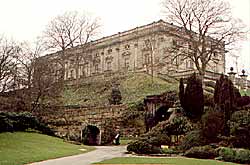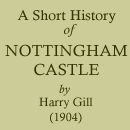< Previous | Contents | Next >
 Nottingham Castle Museum and Art Gallery in 2001.
Nottingham Castle Museum and Art Gallery in 2001.The buildings, however, were left in their ruinous condition for about 40 years, the grounds being used occasionally for purposes of entertainment, until October, 1875, when they were leased by the Duke to the Corporation of Nottingham for 500 years. Three years later the blackened and deserted ruin had been completely transformed, and the historic pile commenced another stage in its career on the 3rd of July, 1875, when the Prince and Princess of Wales (now our gracious King and Queen) visited the Castle, amid demonstrations of loyalty and enthusiasm, to attend the opening ceremony of the Nottingham Art Gallery and Museum.
In addition to the art treasures contained within its walls, the Castle is always worthy of a visit, if only for the magnificent and interesting views to be obtained from the grounds. Standing on the highest point and looking out over the wall, what a panorama is spread out for contemplation! Crowning the wooded eminence on the extreme right (westward) stands the stately Wollaton House, one of the finest examples of Renaissance architecture in the land, designed by John Thorpe and built for Sir Francis Willoughby 1580-1588.
In the middle distance are the remains of the once famous Cluniac Priory of Lenton, founded 1100 by William Peveril, the owner of the Castle.
A little further to the southward the spire of Attenborough Church may be seen, recalling memories of the brave General Henry Ireton; and behind it lies Thrumpton, the home of Piggott, another member of Cromwell’s Parliament, with Red Hill beyond and Bredon Hill and Bulwarks in the far distance.
Looking straight in front, by the banks of what once was the “silvery” Trent, but now, alas! somewhat marred by the smoke and dust of a colliery, the square tower of Wilford Church may be seen. Here Henry Kirke White loved to sit and muse; to the right the gently rising woods of famous Clifton Grove, through which he loved to roam, and beyond, in the far distance, the blue hills of Charnwood, of which the Castle rock is said to be a fragment, detached ages ago by the operations of nature.
Away on the horizon eastwards “Belvoir’s lordly terraces” may be seen on a clear day, and about mid-way between the two castles, on the verge of the great Vale of Belvoir, stands the tiny village of Owthorpe, once the home of Colonel John Hutchinson, the beloved and gallant Governor of the Castle.
Further to the eastward the view is limited by Colwick Hill; over the hill, on the south bank of the Trent, stands the village of East Bridgford, where Colonel Francis Hacker lived, and between Colwick Hill and the Castle nestles the ancient part of the town, with the three churches of St. Mary, St. Peter and St. Nicholas, almost in a line one behind the other; but it must be borne in mind that the square brick tower of the church of St. Nicholas is not the same tower that was standing when the Royalists used it for the purpose of making an attack upon the Castle, but a comparatively modern erection, finished in 1672, to take the place of the old church, which had a stone tower and spire.
Beautiful and complete as the scene still is, it needs a little imagination to picture what it must have been in the days of old, when all between the Castle rock and the river Trent lay smiling meadows, where the burgesses had right of pasturage for their cattle, and where every springtime the vernal crocus spread a flowery carpet of purple all around.
As this purports to be a historical sketch, no mention has been made about a well-known and much debated personage, whom some would have us believe is entirely mythological, but with whom Nottingham people at any rate would be loth to part —I mean the bold forest outlaw Robin Hood, and his merrie men clad in Lincoln green, who are linked together with the Castle in many a ballad and story of the days of King Richard the Lion-heart and King John—but if I may not dwell upon so interesting a theme, I cannot finish these pages without a reference to our battalions of citizen soldiers who perpetuate the name of the bold outlaw. Close by the foot of the flagstaff the visitor will see a marble slab let into the pavement recording the fact that the now famous Robin Hood Rifles held their first meeting for drill here on-Monday, May 3oth, 1859, at six o’clock in the morning, under the instruction of the late Captain and Adjutant Jonathan White. A bronze portrait bust of the beloved adjutant, with a record of his long and meritorious service, stands, on the terrace facing the green.
The granite obelisk on the lower lawn, just to the right on entering, was erected to the memory of officers and men who fell in action or died of their wounds in the Afghan campaign 1878-79-80.
